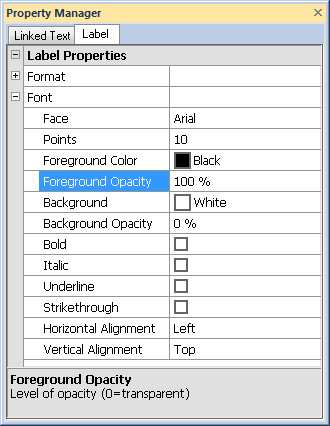
Font properties can be changed for most text objects, including labels. Use the following options to change the text values.

The Font section displays the options for setting the font properties.
Use the Face option to change the font for the text. All TrueType fonts are listed in the font list. to change the font, click on the existing option and select the desired font from the list.
Set the text size in the Points field by scrolling to a new number using the  or by highlighting the existing value and typing a number into the box. Sizes are in points.
or by highlighting the existing value and typing a number into the box. Sizes are in points.
Change the Foreground Color of the text by clicking on the color box. Select a new color by clicking on a color in the color palette. You can create new colors by clicking the Custom button at the bottom of the color palette.
Use the Foreground Opacity to change the opacity of the text. 0% is completely transparent and 100% is completely opaque. To change the value, highlight the existing value and type a new value or click the  to increase or decrease the value.
to increase or decrease the value.
Use Background to change the color fill of a background rectangle that surrounds the text. Click the color box and select from the palette or click Custom to select a custom color.
Use Background Opacity to change the opacity of the background. 0% is completely transparent and 100% is completely opaque. To change the value, highlight the existing value and type a new value or click the  to increase or decrease the value.
to increase or decrease the value.
In most places text options will appear in the Property Manager. In these case, check the box next to the Bold, Italic, Underline, and Strikethrough options to apply one or more of those text styles. Note that some typefaces, such as Symbol, do not support bold or italicized text.
Use Horizontal Alignment to place text horizontally in the selected object. The reference point for alignment is the exact center of the object.
Left horizontally aligns a text box so that the reference point is to the left of the text box. For labels in bar, zone bar, and complex text logs, Left aligns the label to the left side of the bar.
Center horizontally centers the text box on the reference point. For labels in bar, zone bar, and complex text logs, Center aligns the label in the center of the bar.
Right horizontally aligns the text box so that the reference point is to the right of the text box. For labels in bar, zone bar, and complex text logs, Right aligns the label to the right side of the bar.
Use Vertical Alignment to place default text vertically in the selected object. The reference point for alignment is the exact center of the object.
Top vertically aligns the text box so that the reference point is above the text box. For labels in bar, zone bar, and complex text logs, Top aligns the label at the top of the bar.
Center vertically centers the text box on the reference point. For labels in bar, zone bar, and complex text logs, Center aligns the label in the center of the bar.
Baseline vertically aligns the text box so that the reference point is located at the base of the text. The baseline is the imaginary line along which characters are positioned as they are drawn. Descenders on characters are drawn below the baseline. For labels in bar, zone bar, and complex text logs, Baseline aligns the baseline of the label at the center of the bar.
Bottom vertically aligns the text box so that the reference point is below the text box. For labels in bar, zone bar, and complex text logs, Bottom aligns the label at the bottom of the bar.
See Also